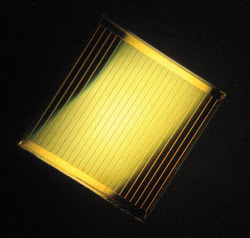Both efficiency and bandgap engineering provide electricity via heat waste recovery.
Two British consortia have received funding from the country’s Technology Strategy Board for the development of thermophotovoltaic (TPV) technology. One project, now finished, set a record for energy conversion efficiency; the other, focusing on a different material platform, has just begun.
Thermophotovoltaic systems consist of solar cells that bring their own sun – where the “sun,” or emitter, usually is radiating in the infrared spectral range, and the actual cells converting the photons into electrons are different from standard solar cells, which are tailored for high efficiency in the visible.
In their classical configuration, TPV systems comprise an emitter – such as a burner – a semiconductor-based converter cell, and filters and reflectors to direct and select the radiation to be converted. This makes them quiet and self-contained – yet nonrenewable – electricity sources with few or no moving parts. Consequently, applications such as remote site and portable electricity generation have been among the most obvious targets for TPVs, not only for off-grid power generators but also to feed battlefield electronics.
Recently, however, their potential use for the recovery of waste heat from industrial plants such as blast furnaces has come into play. Here the emitter and its temperature radiation profile are a given and can no longer be tailored to match the converter cell; thus, engineering the cell’s bandgap is even more important, so that the absorption properties of the cell match the emitter’s IR radiation spectrum.

Cells converting infrared radiation into electricity are key parts of thermophotovoltaic systems. This cell was made using InP, which is well-known because of its widespread use in photonic applications such as integrated optics.
“TPV technology has a lot of potential but is still in its early stages, and one of the main areas for improvement is the conversion efficiency,” said Dr. David Rogers, TPV project manager at the Centre for Integrated Photonics (CIP) Ltd. In his project, which was funded by the Engineering and Physical Sciences Research Council, CIP and its partners, Oxford University and Wafer Technology Ltd., demonstrated a record conversion efficiency of up to 12 per cent from devices with a single p-n junction, based on indium phosphide (InP) materials. This compares with 9 per cent from existing commercially available cells.
Fabrication and growth of InP, including compound InGaAs crystals, is a known technology, making for efficient production and the opportunity to apply some tricks to optimize the bandgap.
In the second consortium, research continues in another more traditional material platform, gallium antimonide (GaSb), which has a bandgap of 0.72 eV – similar to InGaAs – and which has been widely used in TPV research and engineering. This project aims to use alloys such as InAsSb or InGaSbN and to lattice-match them to GaSb substrates, further reducing the bandgap and improving the absorption characteristics at long wavelengths.
“In contrast to InP, the materials are less well understood,” said Dr. Mark Furlong, director of Wafer Technology. “But if this is changed, the benefit can be substantial.” The expectation is that the new cells will more effectively generate electricity from waste heat sources, such as glass melting furnaces, for which temperatures below 1000 °C are particularly relevant.
Partners in the second project include defence company QinetiQ Ltd., Lancaster University and, again, Wafer Technology, which, obviously, has more than one iron in the fire.